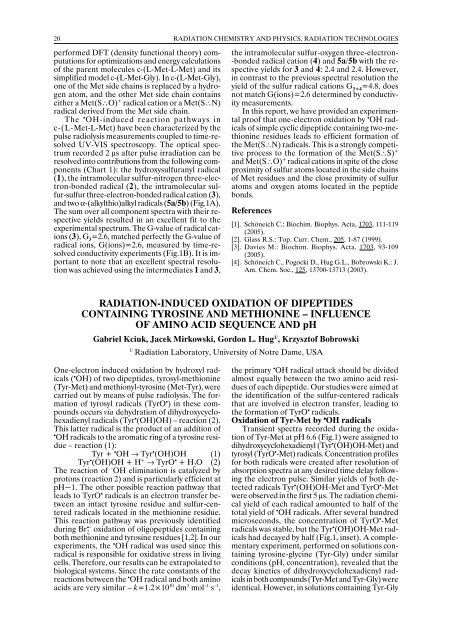annual report annual report annual report annual report 2005
annual report annual report annual report annual report 2005
annual report annual report annual report annual report 2005
Create successful ePaper yourself
Turn your PDF publications into a flip-book with our unique Google optimized e-Paper software.
20<br />
RADIATION CHEMISTRY AND PHYSICS, RADIATION TECHNOLOGIES<br />
performed DFT (density functional theory) computations<br />
for optimizations and energy calculations<br />
of the parent molecules c-(L-Met-L-Met) and its<br />
simplified model c-(L-Met-Gly). In c-(L-Met-Gly),<br />
one of the Met side chains is replaced by a hydrogen<br />
atom, and the other Met side chain contains<br />
either a Met(S∴O) + radical cation or a Met(S∴N)<br />
radical derived from the Met side chain.<br />
The • OH-induced reaction pathways in<br />
c-(L-Met-L-Met) have been characterized by the<br />
pulse radiolysis measurements coupled to time-resolved<br />
UV-VIS spectroscopy. The optical spectrum<br />
recorded 2 µs after pulse irradiation can be<br />
resolved into contributions from the following components<br />
(Chart 1): the hydroxysulfuranyl radical<br />
(1), the intramolecular sulfur-nitrogen three-electron-bonded<br />
radical (2), the intramolecular sulfur-sulfur<br />
three-electron-bonded radical cation (3),<br />
and two α-(alkylthio)alkyl radicals (5a/5b) (Fig.1A).<br />
The sum over all component spectra with their respective<br />
yields resulted in an excellent fit to the<br />
experimental spectrum. The G-value of radical cations<br />
(3), G 3<br />
=2.6, matched perfectly the G-value of<br />
radical ions, G(ions)=2.6, measured by time-resolved<br />
conductivity experiments (Fig.1B). It is important<br />
to note that an excellent spectral resolution<br />
was achieved using the intermediates 1 and 3,<br />
the intramolecular sulfur-oxygen three-electron-<br />
-bonded radical cation (4) and 5a/5b with the respective<br />
yields for 3 and 4: 2.4 and 2.4. However,<br />
in contrast to the previous spectral resolution the<br />
yield of the sulfur radical cations G 3+4<br />
=4.8, does<br />
not match G(ions)=2.6 determined by conductivity<br />
measurements.<br />
In this <strong>report</strong>, we have provided an experimental<br />
proof that one-electron oxidation by • OH radicals<br />
of simple cyclic dipeptide containing two-methionine<br />
residues leads to efficient formation of<br />
the Met(S∴N) radicals. This is a strongly competitive<br />
process to the formation of the Met(S∴S) +<br />
and Met(S∴O) + radical cations in spite of the close<br />
proximity of sulfur atoms located in the side chains<br />
of Met residues and the close proximity of sulfur<br />
atoms and oxygen atoms located in the peptide<br />
bonds.<br />
References<br />
[1]. Schöneich C.: Biochim. Biophys. Acta, 1703, 111-119<br />
(<strong>2005</strong>).<br />
[2]. Glass R.S.: Top. Curr. Chem., 205, 1-87 (1999).<br />
[3]. Davies M.: Biochim. Biophys. Acta, 1703, 93-109<br />
(<strong>2005</strong>).<br />
[4]. Schöneich C., Pogocki D., Hug G.L., Bobrowski K.: J.<br />
Am. Chem. Soc., 125, 13700-13713 (2003).<br />
RADIATION-INDUCED OXIDATION OF DIPEPTIDES<br />
CONTAINING TYROSINE AND METHIONINE – INFLUENCE<br />
OF AMINO ACID SEQUENCE AND pH<br />
Gabriel Kciuk, Jacek Mirkowski, Gordon L. Hug 1/ , Krzysztof Bobrowski<br />
1/<br />
Radiation Laboratory, University of Notre Dame, USA<br />
One-electron induced oxidation by hydroxyl radicals<br />
( • OH) of two dipeptides, tyrosyl-methionine<br />
(Tyr-Met) and methionyl-tyrosine (Met-Tyr), were<br />
carried out by means of pulse radiolysis. The formation<br />
of tyrosyl radicals (TyrO • ) in these compounds<br />
occurs via dehydration of dihydroxycyclohexadienyl<br />
radicals (Tyr • (OH)OH) – reaction (2).<br />
This latter radical is the product of an addition of<br />
•<br />
OH radicals to the aromatic ring of a tyrosine residue<br />
– reaction (1):<br />
Tyr + • OH → Tyr • (OH)OH (1)<br />
Tyr • (OH)OH + H + → TyrO • + H 2 O (2)<br />
The reaction of – OH elimination is catalyzed by<br />
protons (reaction 2) and is particularly efficient at<br />
pH~1. The other possible reaction pathway that<br />
leads to TyrO • radicals is an electron transfer between<br />
an intact tyrosine residue and sulfur-centered<br />
radicals located in the methionine residue.<br />
This reaction pathway was previously identified<br />
during Br 2<br />
•–<br />
oxidation of oligopeptides containing<br />
both methionine and tyrosine residues [1,2]. In our<br />
experiments, the • OH radical was used since this<br />
radical is responsible for oxidative stress in living<br />
cells. Therefore, our results can be extrapolated to<br />
biological systems. Since the rate constants of the<br />
reactions between the • OH radical and both amino<br />
acids are very similar – k=1.2×10 10 dm 3 mol –1 s –1 ,<br />
the primary • OH radical attack should be divided<br />
almost equally between the two amino acid residues<br />
of each dipeptide. Our studies were aimed at<br />
the identification of the sulfur-centered radicals<br />
that are involved in electron transfer, leading to<br />
the formation of TyrO • radicals.<br />
Oxidation of Tyr-Met by • OH radicals<br />
Transient spectra recorded during the oxidation<br />
of Tyr-Met at pH 6.6 (Fig.1) were assigned to<br />
dihydroxycyclohexadienyl (Tyr • (OH)OH-Met) and<br />
tyrosyl (TyrO • -Met) radicals. Concentration profiles<br />
for both radicals were created after resolution of<br />
absorption spectra at any desired time delay following<br />
the electron pulse. Similar yields of both detected<br />
radicals Tyr • (OH)OH-Met and TyrO • -Met<br />
were observed in the first 5 µs. The radiation chemical<br />
yield of each radical amounted to half of the<br />
total yield of • OH radicals. After several hundred<br />
microseconds, the concentration of TyrO • -Met<br />
radicals was stable, but the Tyr • (OH)OH-Met radicals<br />
had decayed by half (Fig.1, inset). A complementary<br />
experiment, performed on solutions containing<br />
tyrosine-glycine (Tyr-Gly) under similar<br />
conditions (pH, concentration), revealed that the<br />
decay kinetics of dihydroxycyclohexadienyl radicals<br />
in both compounds (Tyr-Met and Tyr-Gly) were<br />
identical. However, in solutions containing Tyr-Gly
















